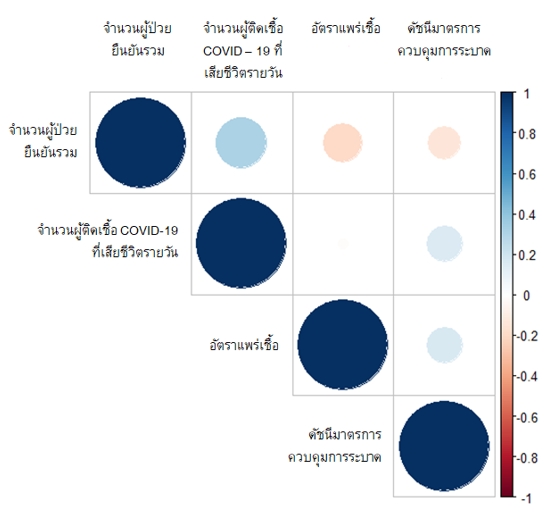ตัวแบบทางสถิติสำหรับศึกษาอัตราอุบัติการณ์การเสียชีวิตของผู้ติดเชื้อ COVID–19 ในกลุ่มประเทศเอเชียตะวันออกเฉียงใต้ (ASEAN)
คำสำคัญ:
ตัวแบบการถดถอยปัวซง, ตัวแบบการถดถอยทวินามลบ, อัตราอุบัติการณ์, อัตราแพร่เชื้อ, ดัชนีมาตรการควบคุมการระบาดบทคัดย่อ
งานวิจัยนี้มีวัตถุประสงค์เพื่อศึกษาความสัมพันธ์ของประเทศในเอเชียตะวันออกเฉียงใต้ จำนวนผู้ป่วยยืนยัน (confirmed case) รวม อัตราแพร่เชื้อ (reproduction rate) และดัชนีมาตรการควบคุมการระบาด (stringency index) กับจำนวนผู้ติดเชื้อ COVID-19 ที่เสียชีวิตรายวัน รวมถึงการสร้างตัวแบบทางสถิติสำหรับศึกษาอัตราอุบัติการณ์การเสียชีวิตของผู้ติดเชื้อ COVID-19 ในกลุ่มประเทศเอเชียตะวันออกเฉียงใต้ (ASEAN) โดยในการศึกษาครั้งนี้ใช้ข้อมูลทุติยภูมิและใช้การวิเคราะห์การถดถอยปัวซงและการวิเคราะห์การถดถอยทวินามลบในการสร้างตัวแบบ ผลการศึกษาพบว่า ตัวแบบการถดถอยปัวซงไม่เหมาะสมกับข้อมูลที่นำมาใช้ในการศึกษาเนื่องจากข้อมูลมีความแปรปรวนสูงกว่าค่าเฉลี่ยเป็นอย่างมากหรือเกิดปัญหาการกระจายเกินเกณฑ์ (overdispersion) โดยมีค่า AIC = 39590.932 ส่วนตัวแบบที่เหมาะสมกับข้อมูลสำหรับศึกษาอัตราอุบัติการณ์การเสียชีวิตของผู้ติดเชื้อ COVID-19 ในกลุ่มประเทศเอเชียตะวันออกเฉียงใต้ (ASEAN) คือ ตัวแบบการถดถอยทวินามลบ (deviance = 1347.708, Pearson chi-square = 1230.049, และ AIC = 8608.771) โดยพบว่า ประเทศไทยมีอัตราหรือความเสี่ยงต่อการเสียชีวิตจาก COVID-19 สูงกว่าประเทศอื่น ๆ ในกลุ่มประเทศเอเชียตะวันออกเฉียงใต้ (ASEAN) โดยประเทศกัมพูชา ประเทศอินโดนีเซีย ประเทศลาว ประเทศมาเลเซีย ประเทศฟิลิปปินส์ ประเทศสิงคโปร์ และประเทศเวียดนาม มีอัตราหรือความเสี่ยงต่อการเสียชีวิตจาก COVID-19 น้อยกว่าประเทศไทย 97.4%, 81.9%, 94.4%, 40.3%, 99.7%, 73.2%, 72.5%, และ 61.8% ตามลำดับ
References
Batra, M., Shah, A.F., Rajput, P., & Shah, I.A. (2016). Comparison of linear and zero-inflated negative binomial regression models for appraisal of risk factors associated with dental caries. Journal of Indian Society of Pedodontics and Preventive Dentistry, 34(1), 71-75.
Byers, A.L., Allore, H., Gill, T.M.,& Peduzzi, P.N. (2003). Application of Negative Binomial Modeling for Discrete Outcomes: A Case Study in Aging Research. Journal of Clinical Epidemiology, 56, 559-564.
Chaiwan, A., Boonho, W.,& Tongkhow, P. (2013). Risk Factors for Defective Products in Autoparts FactoryUsing Generalized Linear Model (GLM). In The 10th National Kasetsart University Kamphaeng Saen Conference, (pp. 238-246).Nakhon Pathom.
Chaiyawan,A.,Boonho, W., & Tongkhan, P.(2013). Analysis of risk factors for defective products in automobile parts factories using general linear models (GLM). National Academic Conference. Kasetsart University Kamphaeng Saen Campus 9th, Kasetsat university. (in Thai)
Charatiam, N. (2010). Comparative Test Statistics for Zero-Inflated Generalized Poisson Regression Model.against Generalized Poisson Regression Model in the Presence of Covariate Outliers[Unpublished master’s thesis].Thammasat University. (in Thai)
Guo, Y.R., Cao, Q.D., Hong, Z.S., Tan, Y.Y., Chen, S.D., Jin, H.J., Tan, K. S., Wang, D. Y., & Yan, Y.(2020). The origin, transmission and clinical therapies on coronavirus disease 2019 (COVID-19) outbreak -an update on the status. Military Medical Research, 7, 1-10.
Hu, M.C., Pavlicova, M., & Nunes, E.V. (2011).Zero-inflated and Hurdle Models of Count Data with Extra Zeros: Examples form an HIV –Risk Reduction Intervention Trial. Journal of Drug Alcohol Abuse, 37(5), 367 –375.
McCullagh, P.,& Nelder, J. (1989). Generalized Linear Models(2nded.). Boca Raton: Chapman and Hall/CRC.
Moghimbeigi, A., Eshraghian, M.R., Mohammad, K., & Mcardle, B. (2008). Multilevel zeroinflated negative binomial regression modeling for over-dispersed count data with extra zeros'. Journal of Applied Statistics, 35(10), 1193-1202.
Molla, D.T.,& Muniswamy, B. (2012). Power of Tests for Overdispersion Parameter in Negative Binomial Regression Model. Journal of Mathematics, 1(4), 29-36.
Neter, J., Kutner, M.H., Nachtsheim, C.J.,& Wasserman, W. (1996). Applied linear statistical models (Book 1)(4thed.). Chicago, USA : Irwin.
Nettha,L.(2563). Lessons learned from the COVID-19 response of ASEAN member countries. https://lawforasean.krisdika.go.th/File/files/article_2_May_AMS_covid19.pdf(in Thai)
Office of the Royal Society.(2561). Dictionary of statistical terms Royal Institute edition. Bangkok: Office of the Royal Society.(in Thai)
Pramanick, M. B. B. S., Choolani, M., & Seng, L. B. (2021). The epidemiology of COVID-19 in ten Southeast Asian countries. Med J Malaysia, 76(6), 783.
Puno, G.R. (2021). COVID-19 case fatality rates across Southeast Asian countries (SEA): a preliminary estimate using a simple linear regression model. Journal of Health Research, 35(3), 286-294.
Tran, T.T.P., Khuong, L.Q., Dao, A.T.M., Nguyen, H.V., Djalante, R.,& Tran, H.T.T. (2020). The COVID-19 pandemic in the ASEAN: A preliminary report on the spread, burden and medical capacities. Asian Pacific Journal of Tropical Medicine, 13(6), 247-251.
Üçer, B. H., & Çelikoğlu, C. (2004). Latent process in a Poisson regression model.Journal of Science and Technology, 5(2), 259-267.
Violato, C., Violato, E.M.,& Violato, E.M. (2021). Impact of the stringency of lockdown measures on covid-19: A theoretical model of a pandemic. PLOS ONE, 16(10),e0258205.
Vittinghoff, E., Glidden, D.V., Shiboski, S.C.,& McCulloch, C.E. (2011). Regression Methods in Biostatistics: Linear, Logistic, Survival, and Repeated Measures Models. New York, NY: Springer.
Yesilova, A.,&Yilmaz, A. (2007). The Application of Overdispersion and Generalized Estimating Equations in Repeated Catagorical Data Related to the Sexual Behaviour Traits of Farm Animals. Journal of Applied Sciences, 7(12), 1762-1767.
Yusuf, O.B., Bello, T., & Gureje, O. (2017). Zero Inflated Poisson and Zero Inflated Negative Binomial Models with Application to Number of Falls in the Elderly. Biostatistics and Biometrics Open Access Journal, 1(4), 1-7.
Zhu, N., Zhang, D., Wang, W., Li, X., Yang, B.,&Song, J.(2020) A novel coronavirus from patients with pneumonia in China, 2019. The New England Journal of Medicine, 382, 727-33.

Downloads
เผยแพร่แล้ว
License
Copyright (c) 2023 Journal of Applied Science and Emerging Technology

This work is licensed under a Creative Commons Attribution-NonCommercial-NoDerivatives 4.0 International License.
